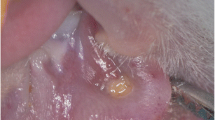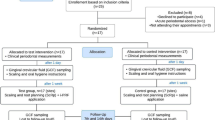Abstract
Oral traumatic ulcers (OTU) are common in dental routine, and the control of proinflammatory cytokines, such as the tumor necrosis factor-alpha (TNF-α), may interfere with OTU repair. Our aim was to evaluate the role of TNF-α in the healing process of OTU in rats. Wistar male rats were divided into six groups: a control-group (treated with 0.1 mL/kg of saline) and five groups treated with anti-TNF-α infliximab (INF) at 1, 3, 5, 7, and 10 mg/kg immediately before OTU production. The animals were weighed (day 0) and euthanized on days 1, 3, 7, 14 and 21 after ulceration. The ulcers were clinically measured, and the mucosa samples were histologically (scores 0–4), histochemically (collagen assay (pircrosirius)), histomorphometrically (cell counting), and immunohistochemically (TNF-α, α-smooth-muscle-actin (α-SMA), monocyte-chemoattractive-protein-1 (MCP-1), interleukin-8 (IL-8), and fibroblast-growth-factor (FGF)) analyzed. The Evans blue assay was used to measure the vascular permeability. ANOVA-1–2-way/Bonferroni, Kruskal–Wallis/Dunn, and correlation analyses were performed (GraphPad Prism 5.0, p < 0.05). High doses of INF reduced the OTU area (p = 0.043), body mass loss (p = 0.023), vascular permeability (p < 0.001), and reduced delayed histologic scores (p < 0.05), polymorphonuclear (p < 0.001) and mononuclear (p < 0.001) cells, blood vessel counting (p = 0.006), and total (p < 0.001), type-I (p = 0.018), and type-III (p < 0.001) collagen. INF treatment reduced TNF-α immunostaining and delayed MPC-1, FGF, and α-SMA expression, with little/none influence in IL-8 immunostaining. TNF-α blockage by INF reduced acute inflammation in OTU but delayed cell migration and wound healing.






Similar content being viewed by others
Data availability
Enquiries about data availability should be directed to the authors.
References
Almoznino G, Ben-Chetrit E (2007) Infliximab for the treatment of resistant oral ulcers in Behçet’s disease: a case report and review of the literature. Clin Exp Rheumatol 25:s99 (PMID: 17949561)
Baggioloni M, Lewis IC (1992) Interleukin-8, a chemotactic and inflammatory cytokine. FEBS Lett 307:97–101. https://doi.org/10.1016/0014-5793(92)80909-Z
Barreto RSS, Quintans JSS, Amarante RKL, Nascimento TS et al (2016) Evidence for the involvement of TNF-α and IL-1β in the antinociceptive and anti-inflammatory activity of Stachys lavandulifolia Vahl. (Lamiaceae) essential oil and (-) -α-bisabolol, its main compound, in mice. J Ethnopharmacol 191:9–18. https://doi.org/10.1016/j.jep.2016.06.022
Bokemeyer A, Tentrop N, Barth PJ, Lenze F, Hengst K, Kleinheinz J, Bettenworth D (2018) Successful treatment of oral Crohn’s disease by anti-TNF-alpha dose escalation—a case report. BMC Gastroenterol 18:88. https://doi.org/10.1186/s12876-018-0818-7
Bongartz T, Sutton AJ, Sweeting MJ, Buchan I et al (2006) Anti-TNF antibody therapy in rheumatoid arthritis and the risk of serious infections and malignancies: systematic review and meta-analysis of rare harmful effects in randomized controlled trials. JAMA 295:2275. https://doi.org/10.1001/jama.295.19.2275
Brizeno LAC, Assreuy AMS, Alves APNN, Sousa FB et al (2016) Delayed healing of oral mucosa in a diabetic rat model: Implication of TNF-α, IL-1β and FGF-2. Life Sci 155:36. https://doi.org/10.1016/j.lfs.2016.04.033
Carvalho FB, Andrade AS, Rasquin LC, Castro IV et al (2015) Effect of laser (λ 660 nm) and LED (λ 630 nm) photobiomodulation on formocresol-induced oral ulcers: a clinical and histological study on rodents. Lasers Med Sci 30:389. https://doi.org/10.1007/s10103-014-1680-7
Cheng K-Y, Lin Z-H, Cheng Y-P, Chiu H-Y, Yeh N-L, Wu T-K, Wu J-S (2018) Wound healing in streptozotocin induced diabetic rats using atmospheric-pressure argon plasma jet. Sci Rep 8:12214. https://doi.org/10.1038/s41598-018-30597-1
Duarte CME, Quirino MRS, Patrocínio MC, Anbinder AL (2011) Effects of Chamomilla recutita (L.) on oral wound healing in rats. Med Oral Patol Oral Cir Bucal 16:716. https://doi.org/10.4317/medoral.1702
Geesin JC, Hendricks LJ, Gordon JS, Berg RA (1991) Modulation of collagen synthesis by growth factors: the role of ascorbate-stimulated lipid peroxidation. Arch Biochem Biophys 289:6. https://doi.org/10.1016/0003-9861(91)90434-k
Gonçalves DC, Evangelista RC, Santos MJ, Silva-Jr FS et al (2014) Infliximab attenuates inflammatory osteolysis in a model of periodontitis in Wistar rats. Exp Biol Med (maywood) 239:442. https://doi.org/10.1177/1535370213520114
Hernández JC, Lopez JA, Torrent RB, Jimenez EI et al (2015) Tuberculosis in pediatric patients treated with anti-TNFα drugs: a cohort study. Pediatr Rheumatol Online J 13:54. https://doi.org/10.1186/s12969-015-0054-4
Hitomi S, Ono K, Yamaguchi K, Terawaki K et al (2016) The tradicional Japanese medicine hangeshashinto alleviates oral ulcer-induced pain in rat model. Arch Oral Biol 66:30. https://doi.org/10.1016/j.archoralbio.2016.02.002
Ito K, Shikata K, Haba K, Ito T (2019) Refractory oral ulcer responsive to infliximab: a case report. ORL 81:240. https://doi.org/10.1159/000500575
Jentzer A, Berger AE, Labetoulle R, Haccourt A (2018) Short Communication: Evaluation of infliximab and anti-infliximab LISA-TRACKER immunoassays for the therapeutic drug monitoring of SB2 infliximab biosimilar. Ther Drug Monit 40:749. https://doi.org/10.1097/FTD.0000000000000565
Jetten N, Verbruggen S, Gijbels MJ, Post MJ et al (2014) Anti-inflammatory M2, but not pro-inflammatory M1 macrophages promote angiogenesis in vivo. Angiogenesis 17:109. https://doi.org/10.1007/s10456-013-9381-6
Kaneider NC, Reinisch CM, Dunzendorfer S, Meierhofer C et al (2001) Induction of apoptosis and inhibition of migration of inflammatory and vascular wall cells by cerivastatin. Atherosclerosis 158:23. https://doi.org/10.1016/s0021-9150(00)00764-4
Kirchner S, Holler E, Haffner S, Andreesen R, Eissner G (2004) Effect of different tumor necrosis factor (TNF) reactive agents on reverse signaling of membrane integrated TNF in monocytes. Cytokine 28:67. https://doi.org/10.1016/j.cyto.2004.06.008
Lima AAS, Grégio AMT, Tanaka O, Machado MAN, França BHS (2005) Tratamento das ulcerações traumáticas bucais causadas por aparelhos ortodônticos. Rev Dent Press Ortodon Ortop Facial 10:30. https://doi.org/10.1590/S1415-54192005000500005
Mesquita KC, Dantas TS, Silva PGB, Rodrigues MIQ et al (2020) Abatacept treatment impairs the cell migration and wound healing of oral ulcers in rats: Role of interleukin (IL)-1β, -6 and -10 and CD8/CD30 cells: Influence of abatacept treatment on oral wound healing: experimental model on rats. Life Sci 243:117243. https://doi.org/10.1016/j.lfs.2019.117243
Murray PJ, Wynn TA (2011) Protective and pathogenic functions of macrophage subsets. Nat Rev Immunol 11:723. https://doi.org/10.1038/nri3073
Nishi O, Nishi K, Fujiwara T, Shirasawa E, Ohmoto Y (1996) Effects of the cytokines on the proliferation of and collagen synthesis by human cataract lens epithelial cells. Br J Ophthalmol 80:63. https://doi.org/10.1136/bjo.80.1.63
Oliveira BV, Silva PGB, Nojosa JS, Brizeno LAC et al (2016) TNF-alpha expression, evaluation of collagen, and TUNEL of Matricaria recutita L. extract and triamcinolone on oral ulcer in diabetic rats. J Appl Oral Sci 24:278. https://doi.org/10.1590/1678-775720150481
Puspasari A, Harijanti KB, Soebadi B, Tuti H et al (2018) Effects of topical application of propolis extract on fibroblast growth factor-2 and fibroblast expression in the traumatic ulcers of diabetic Rattus norvegicus. J Oral Maxillofac Pathol 22:54. https://doi.org/10.4103/jomfp.JOMFP_82_17
Rice TL, Chantler I, Loram LC (2008) Neutralisation of muscle tumour necrosis factor alpha does not attenuate exercise-induced muscle pain but does improve muscle strength in healthy male volunteers. Br J Sports Med 42:758. https://doi.org/10.1136/bjsm.2007.038067
Ritsu M, Kawakami K, Kanno E, Tanno H et al (2017) Critical role of tumor necrosis factor-α in the early process of wound healing in skin. J Dermat Dermatologic Surg 21:14. https://doi.org/10.1016/j.jdds.2016.09.001
Ryu HJ, Seo MR, Choi HJ, Baek HJ (2014) Infliximab for refractory oral ulcers. Am J Otolaryngol 35:664. https://doi.org/10.1016/j.amjoto.2014.04.014
Santos-Moreno P, Sanchez G, Castro C (2019) Rheumatoid factor as predictor of response to treatment with anti-TNF alpha drugs in patients with rheumatoid arthritis: results of a cohort study. Medicine (baltimore) 98:14181. https://doi.org/10.1097/MD.0000000000014181
Silva PGB, Codes EBB, Freitas MO, Martins JOL et al (2018) Experimental model of oral ulcer in mice: Comparing wound healing in three immunologically distinct animal lines. J Oral Maxillofac Pathol 22:444. https://doi.org/10.4103/jomfp.JOMFP_144_17
Taxonera C, Olivares D, Mendoza JL, Rubio MD, Rey E (2014) Need for infliximab dose intensification in Crohn’s disease and ulcerative colitis. World J Gastroenterol 20:9170. https://doi.org/10.3748/wjg.v20.i27.9170
Thakrar P, Aclimandos W, Goldmeier D, Setterfield JF (2018) Oral ulcers as a presentation of secondary syphilis. Clin Exp Dermatol 43:868. https://doi.org/10.1111/ced.13640
Theiss AL, Simmons JG, Jobin C, Lund PK (2005) Tumor necrosis factor (TNF) alpha increases collagen accumulation and proliferation in intestinal myofibroblasts via TNF receptor 2. J Biol Chem 280:36099. https://doi.org/10.1074/jbc.M505291200
Tseng SCG, Jarvinen MJ, Nelson WG, Huang JW et al (1982) Correlation of specific keratins with different types of epithelial differentiation: monoclonal antibody studies. Cell 30:361. https://doi.org/10.1016/0092-8674(82)90234-3
Varin A, Gordon S (2009) Alternative activation of macrophages: immune function and cellular biology. Immunobiology 214:630. https://doi.org/10.1016/j.imbio.2008.11.009
Vitale RF, Ribeiro FAQ (2007) The role of tumor necrosis factor-alpha (TNF-alpha) in bone resorption present in middle ear cholesteatoma. Braz J Otorhinolaryngol 73:117. https://doi.org/10.1016/s1808-8694(15)31133-2
Vollmer O, Felten R, Mertz P, Lebrun-Vignes B et al (2020) Characterization of auto-immune hepatitis associated with the use of anti-TNFα agents: an analysis of 389 cases in VigiBase. Autoimmun Rev 19:102460. https://doi.org/10.1016/j.autrev.2020.102460
Xiao Q, Guan Y, Li C, Liu L et al (2018) Decreased expression of transforming growth factor-β1 and α-smooth muscle actin contributes to the protection of lotensin against chronic renal failure in rats. Ren Fail 40:583. https://doi.org/10.1080/0886022X.2018.1496934
Funding
The authors have not disclosed any funding.
Author information
Authors and Affiliations
Corresponding author
Ethics declarations
Competing interests
The authors have not disclosed any competing interests.
Additional information
Publisher's Note
Springer Nature remains neutral with regard to jurisdictional claims in published maps and institutional affiliations.
Supplementary Information
Below is the link to the electronic supplementary material.
10787_2022_1046_MOESM1_ESM.tif
Supplementary file 1. IL-8 immunostaining profile maturation of OTU during healing in rats treated with different doses of INF. Immunohistochemistry, DAB-hematoxylin staining; light microscopy; magnification = 400 X; black barr = 50 µm
10787_2022_1046_MOESM2_ESM.tif
Supplementary file 2. FGF immunostaining profile maturation of OTU during healing in rats treated with different doses of INF. Immunohistochemistry, DAB-hematoxylin staining; light microscopy; magnification = 400 X; black barr = 50 µm
Rights and permissions
Springer Nature or its licensor holds exclusive rights to this article under a publishing agreement with the author(s) or other rightsholder(s); author self-archiving of the accepted manuscript version of this article is solely governed by the terms of such publishing agreement and applicable law.
About this article
Cite this article
Freitas, M.O., Fonseca, A.P.R., de Aguiar, M.T. et al. Tumor necrosis factor alpha (TNF-α) blockage reduces acute inflammation and delayed wound healing in oral ulcer of rats. Inflammopharmacol 30, 1781–1798 (2022). https://doi.org/10.1007/s10787-022-01046-3
Received:
Accepted:
Published:
Issue Date:
DOI: https://doi.org/10.1007/s10787-022-01046-3




